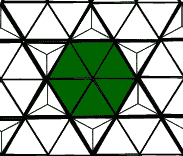
The grid on which the neighbourhood is based.
This isometric neighbourhood is composed of two simultaneously-applied "stellated" maps. The two maps are shown in "Part 1" and "Part 2" diagrams (above). In the larger diagrams at the bottom, an attmpt to indicate how the pattern tesselates is made. Two triangular mappings occur for each hexagonal mapping. Note that the diagram at the bottom could be misinterpreted - it is a composite of three distinct domains and co-domains. You could apply them tochether as a single map - but then the maximum distance from points in the domain to points in the co-domian becomes rather large - and this is against the spirit of locality. Also then the pattern is liable to lose its twelve-fold symmetry. The smaller, simpler-looking diagrams at the top explain what is happening most clearly. The neighbourhood divides the plane into two non-interacting sub-lattices.
|





